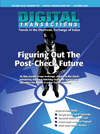Articles and Opinions
"It's odd that companies like PayPal can innovate using existing payments system infrastructure, while banks continue to search for the silver bullet."
George Thomas
Sign up to receive the latest articles from Radix Consulting.
Views On Checks
The process of converting a check at the earliest point of capture and converting the transaction to an ACH debit. While it currently works well for certain applications such as accounts receivable conversion (ARC) it is not suited for other applications such as business check conversion.
![]()
Converting a point-of-sale check in the back office rather than at the point-of-presentment became a NACHA rule on March 16, 2007. The application has been often referred to by those in the industry as the same type of transaction as ARC. The two applications could not be any more different.
|
View Article: Letter to the American Banker |
![]()
In 2005, George Thomas wrote a letter to the editor of the American Banker to present another point of view on why business check conversion was not inevitable.
|
View Article: Letter to the American Banker |
![]()
Why Banks Should Combine NACHA And ECCHO
No time should be lost on items that are already being exchanged
electronically. The
industry must spend
its time on getting
more financial
institutions to do
image exchange,
check conversion,
and native electronic
payments.
The following article appeared in the October 2007 issue of Digital Transactions Magazine www.digitaltransactions.net - Copyright 2007 Boland Hill Media LLC. All rights reserved. Reprinted with permission of the publisher.
7  |
View Article: Why Banks Should Combine NACHA And ECCHO Published in Digital Transactions - October 2007 |
![]()
Views On the U.S. Electronic Payments Systems
Banking Industry Approach
The industry has never had a cohesive plan to move to an electronic payment environment from a paper one. Products such as Direct Deposit for payroll and other disbursement applications which have benefits for everyone have never been aggressively marketed by the industry. It has taken 30 years to get to a 70% acceptance level of direct deposit for payroll. Contrast that to the aggressive marketing by Visa of its Visa Check Card which has seen astronomical growth over the past several years. The industry has been too enamored with the check and the revenue the check brings, it is only over the last five years that there is a growing interest of moving away from paper. Applications such as WEB, TEL and Direct Payment eliminate the writing of the check. Applications such as ARC and the newly approved BOC convert the check at the presentment point but do nothing to eliminate the issuance of the check.
Over the next five years, the industry needs to focus its attention on promoting native electronic payments, those payments that travel end-to-end with no human intervention. To accomplish this Herculean task, significant improvements must be made to the banking systems for ACH and Wire transfer payment initiation. Internet banking platforms will need to be enhanced so that bill payments initiated electronically do not come out the back end as a check and that all payments made person-to-person, consumer-to-business (small and large) and business-to-consumer are made electronically. Business banking platforms need to be modified to provide more automation and handle the remittance information that will allow automated posting and reconciliation. The Clearing House Payments Company has been trying to provide leadership but it has been a struggle to get other groups to understand what needs to be done. Some are just hung up with the not-invented here syndrome.
![]()
The Decade of Native Electronic Payments: 2010 and Beyond
What is a native electronic payment? One that is originated electronically and is received by the beneficiary in an automated manner without the use of paper.
7  |
View Article: The Decade of Native Electronic Payments Published in AR Matters - March - April 2010 |
![]()
U.S. B2B Electronic Payments Landscape -- A Highway with Limited Access Ramps
Most people take for granted the importance of the Interstate Highway System that was developed over the last fifty years. The highway system was essential to the economic development of the United States.
7  |
View Article: The U.S. B2B Electronic Payments Landscape, Published in AFP Exchange April 2008 |
![]()
Viewpoint:Expanded Remittance Information is Coming, So Get Ready
The banks that are willing to offer origination services and information delivery to their business customers will have an immediate competitive advantage over those that do not.
|
View Article:Expanded Remittance Information is Coming |
![]()
Viewpoint: Enhancing Wire Transfers to Attract Consumers
Wire transfer product managers need to create new transaction types that would accommodate transactions initiated or received by consumers. We need a way to make wire payments more relevant.
|
View Article: Enhancing Wire Transfers |
![]()
Enhancing the Wire Transfer Systems - The Dilemma – ISO 20022 or STP 820?
In 2006, The Federal Reserve Banks and The Clearing House Payments Company conducted research which concluded that the U.S. dollar wire transfer systems – Fedwire and CHIPS - need to be enhanced in order to be viable options for the migration of some business-to-business checks to wire transfer payments.
7  |
View Article: Wire Transfer Debate Published in AFP Exchange - May 2007 |
![]()
Viewpoint: STP 820's the Best Format for B2B Wire Transfer
The New York Fed and The Clearing House clearly indicated that automation and payment information capability (invoice data) for business payments was needed on the Fedwire and Chips payments systems. They believed that the main hurdle to overcome was deciding what technical format to use for the invoice data
|
View Article: American Banker Viewpoint |
![]()
Demystifying Electronic Money Transfers
Why is it so hard to pay someone else electronically out of your bank account? The answer is, it should’t be. All the pieces are available to banks to build a powerful account-to-account transfer service, if they would only use them.
The following article appeared in the May 2007 issue of Digital Transactions Magazine www.digitaltransactions.net - Copyright 2007 Boland Hill Media LLC. All rights reserved. Reprinted with permission of the publisher.
7  |
View Article: Demystifying Electronic Money Transfers Published in Digital Transactions - May 2007 |
![]()
Ignoring the Unbanked: Reserve Bank of India Mobile Payments Guidelines
The recent release of the final Mobile Payment Guidelines by the Reserve Bank of India (RBI) is extremely disturbing because the unbanked population of India is excluded.
7  |
View Article: Ignoring the Unbanked Published in Global Treasury News December 8, 2008 |
![]()
Mobile Banking - Is it Bank Versus Non-Bank?
This presentation explores the questions of whether mobile payment services are the exclusive domain of banks.
7  |
View Presentation: Is it Bank Versus Non-Bank June 4, 2009 |
![]()
Making Mobile or Internet Person-2-Person Payments A Breeze
With all the hoopla around mobile banking and mobile payments, did you ever wonder how a payment will be sent from your bank account to the person you want to pay? Are you going to have to transfer the money to PayPal and then send it, requiring the person that is receiving the payment to join PayPal? Or are you going to use your home banking system which will probably send a check to the receiver?
Would’t it be nice to connect to your bank account and send an electronic payment without effort to the receiver? It is possible and it can be accomplished using the payment infrastructure that is in place today.
|
View Article: Making Person-2-Person (P2P) Payments for Mobile and Home Banking a Breeze Published in NACHA's Electronic Payment Journal May/June 2007 |
![]()
Viewpoint: Remote Checks Pose High Risk
The Federal Banking Regulators and Federal Trade Commission are very concerned with the increased use of remotely created checks for illegal activities such as fraudulent telemarketing, gambling, internet tobacco sales and child pornography. These instruments are also heavily used by merchants with questionable business practices. The banking industry needs to take proactive steps to address this risk.
|
Published in American Banker - January 2010 |
![]()
Tools for ACH and Demand Draft Risk Management
Would anyone in their right mind attempt to drive a car blindfolded? Well, the answer would be an emphatic “No” because of the dire consequences. So, why do so many banks operate their ACH and check systems completely in the dark? Surely the potential consequences of such actions could be just as dire.
|
View Article: Tools for ACH and Demand Published in ICBA Article Archive - May 2009 |
![]()
It's Time to Dump Demand Drafts
With the ACH and other electronic solutions now available, paper
instruments like demand drafts and remotely created checks serve
no purpose other than to drive up risk for banks, consumers, and
processors. It’s risk the payments system can no longer afford.
The following article appeared in the July 2008 issue of Digital Transactions Magazine www.digitaltransactions.net - Copyright 2008 Boland Hill Media LLC. All rights reserved. Reprinted with permission of the publisher.
7  |
View Article: It's Time to Dump Demand Drafts Published in Digital Transactions - July 2008 |
![]()
The Big Risk in Instant Account Verification
Non-account-holding banks are starting to ask consumers for their passwords and other log-on credentials to make sure they own the accounts they’re using to make payments. At a time of massive data breaches, this is a dangerous practice that should stop now.
The following article appeared in the February 2008 issue of Digital Transactions Magazine www.digitaltransactions.net - Copyright 2008 Boland Hill Media LLC. All rights reserved. Reprinted with permission of the publisher.
7  |
View Article: The Big Risk in Account Verification Published in Digital Transactions - February 2008 |
![]()
Letter to the Editor: Prevention the Real Task in ACH Fraud
The greatest problem the network faces is transactions originated by third-party merchant processors. Historical return-pattern tracking conducted by the ACH operators and Nacha has clearly indicated that the majority of questionable behavior has originated primarily from third-party merchant processors and the financial institutions that originate transactions for them.
|
View Article: Letter to the American Banker Published November 30, 2007 |
![]()
A Looming New Risk to Financial Institutions - International ACH
Today for ACH transactions, Office of Foreign Assets Control (OFAC)
compliance requires a financial institution to block any transfer to or from an account on
its books, if that entity is on the Specially Designated Nationals (SDN) list supplied by
OFAC. Compliance with OFAC will become much more complex when NACHA
implements the International ACH Transaction (IAT Standard Entry Class Code) in
March 2009.
7  |
View Article: A Looming New Risk to Financial Institutions - International ACH Published in Independent Banker - November 2007 |
![]()
The Automated Clearing House (ACH) offers a fast, inexpensive and reliable means of moving payments. It has also been a very safe payments mechanism for the past 30 years. As a result, new types of ACH payments have been introduced that have increased the volume by leaps and bounds, but have also significantly increased the risk to the entire network.
7  |
View Article: Not Your Father's ACH Published in Independent Banker - July 2007 |
![]()
Know Your Customer's Customer
The majority of fraudulent, illegal and questionable business activity is introduced into the Payments System by Third Party Merchant Processors. These entities use the Check, ACH and Credit Card Networks for legitimate and illegal activity. The illicit activity is the result of ineffective due diligence procedures employed by financial institutions and the processors. This presentation highlighs the risks and the consequences of not controlling this activity.
7  |
View Article: Know Your Customer's Customers |



